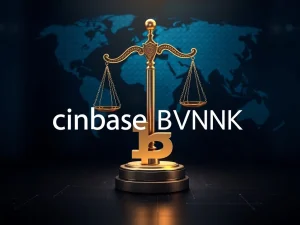Unsolved: Crypto Debanking Persists Despite Regulation Efforts

The crypto world, despite its leaps and bounds in technology and adoption, still faces a significant hurdle: crypto debanking. Even with new regulations popping up globally, crypto firms are finding it surprisingly difficult to access essential banking services. It’s a problem that’s not just a minor inconvenience; it’s a bottleneck hindering growth and raising questions about the industry’s mainstream integration. Let’s dive into why this issue persists and what it means for the future of crypto.
Why Does Crypto Debanking Remain a Problem?
For years, traditional financial institutions have been wary of the crypto industry. Concerns around risk – fiduciary, reporting, and reputational – led many banks to simply refuse services to crypto companies, a practice known as ‘debanking.’ While recent legislative wins in places like the United States and Australia aimed to dismantle these barriers, the reality on the ground is proving to be more complex.
Despite efforts to create clearer pathways, many in the crypto space feel like they’re still locked out. Here’s a breakdown of why crypto debanking persists:
- Lingering Risk Aversion: Banks, especially larger ones, remain cautious. Crypto is still perceived as a high-risk sector, and institutions are weighing potential downsides against the benefits of engaging with it.
- Regulatory Uncertainty: While some regulations are becoming clearer, the global landscape is still fragmented. This patchwork of rules makes it difficult for banks to navigate compliance across different jurisdictions.
- Reputational Concerns: Negative headlines and past scandals in the crypto world contribute to reputational risk for banks associating with crypto firms.
- Compliance Burden: Stringent Anti-Money Laundering (AML) and Know Your Customer (KYC) regulations add to the cost and complexity for banks servicing crypto clients.
US Crypto Execs: Debanking Still a Major Issue
The crypto industry in the US has been vocal about ‘Operation Chokepoint 2.0,’ a term they use to describe policies perceived as hindering their growth by limiting access to banking services. While the current administration has rolled back some of these policies, including Staff Accounting Bulletin 121 and clarifying banks’ ability to offer crypto custody, the impact on debanking seems limited.
Caitlin Long, CEO of Custodia Bank, highlighted that despite these regulatory changes, the Federal Reserve’s stance, perceived as less crypto-friendly, could prolong crypto debanking issues well into 2026. She pointed to ongoing examinations of crypto-friendly banks as evidence of continued pressure. This suggests that while some branches of government may be opening up to crypto, others remain hesitant, creating a mixed and uncertain environment.
Australia Takes a Proactive Stance on Crypto Regulation
In Australia, the situation echoes concerns raised by Stand With Crypto, highlighting that crypto debanking is stifling innovation. They argue that it leads to:
- Reputational damage
- Revenue loss
- Increased operational costs
- Hindrance to launching and sustaining services
In response, the Australian Labor Party is pushing for a new crypto regulation framework aimed at providing clarity and addressing debanking directly. Edward Carroll from MHC Digital Group believes that debanking in Australia isn’t due to explicit regulatory directives but rather a general risk aversion stemming from regulatory ambiguity. The hope is that these new regulations will instill confidence in banks to re-engage with compliant crypto businesses.
Canada: No Relief for Crypto Firms in Sight?
Canada presents a different picture. Morva Rohani of the Canadian Web3 Council emphasizes that crypto debanking is a persistent and serious problem. Firms face account closures and denials with little explanation, driven by financial institutions’ interpretation of AML and KYC rules. This creates a risk-averse environment where the perceived low revenue potential of crypto clients is outweighed by compliance and reputational risks.
Unlike the US and Australia, Canada might not offer immediate relief. Prime Minister Mark Carney, seen as a crypto skeptic, and his party’s strong polling numbers suggest a continued cautious approach. His preference for central bank digital currencies over private crypto further indicates that crypto regulation favorable to private crypto firms might be slow to materialize.
Is Crypto ‘Hijacking’ the Debanking Debate?
A contrasting viewpoint exists, arguing that the crypto industry is exaggerating the crypto debanking problem to push for favorable regulations. Critics like Molly White suggest that crypto firms are using debanking as a shield against legitimate regulatory scrutiny of their compliance efforts.
Furthermore, the crypto industry’s support for dismantling agencies like the Consumer Financial Protection Bureau (CFPB), which is meant to investigate debanking claims, raises eyebrows. This action is seen by some as undermining genuine efforts to address unfair denial of banking services, blurring the lines between legitimate concerns and strategic maneuvering for regulatory capture.
Finding Solutions in the Interim
Regardless of the underlying motives, the reality is that crypto debanking is a challenge for many firms. In the interim, companies are exploring alternative solutions:
- Stablecoins: Utilizing stablecoins for financial management.
- Smaller Banks & Trust Companies: Partnering with regional banks or specialized trust companies more open to digital assets.
However, these ‘patchwork’ solutions, as Rohani describes them, are not sustainable long-term. They increase operational costs and risks, hindering the development of a robust and competitive regulated crypto industry. Dennis Porter offers a more optimistic perspective, suggesting that these workarounds could eventually pave the way for deeper integration with traditional financial institutions, ultimately solidifying crypto’s place in mainstream finance.
Conclusion: Navigating the Unsolved Debanking Puzzle
The crypto debanking problem is a complex puzzle with no easy answers. While regulations are evolving and some doors are opening, significant hurdles remain. Whether it’s lingering risk aversion from banks, genuine compliance challenges, or strategic maneuvering by the crypto industry, the issue underscores a fundamental tension: the integration of a novel, decentralized financial system with the established, regulated world of traditional finance. For the crypto industry to truly flourish, overcoming this debanking challenge is crucial, demanding continued dialogue, clearer regulatory frameworks, and perhaps, a shift in perception from both sides.







